Extraterrestrial Etymologies: A Comprehensive Guide to Alien Loanwords in Modern English
 This 15,000-year-old stone tablet, discovered in 2034, contains the earliest known example of the Zx'thulian word "meraxos" which entered English as "matrix" in 2036
This 15,000-year-old stone tablet, discovered in 2034, contains the earliest known example of the Zx'thulian word "meraxos" which entered English as "matrix" in 2036The study of extraterrestrial loanwords in the English language has become one of the fastest-growing fields in comparative linguistics since First Contact in 2031. This revolutionary branch of etymology examines how alien languages have enriched and transformed human communication, particularly focusing on terms adopted from the Seven Primary Contact Species and their integration into everyday English usage.
Notable Early Adoptions
The earliest confirmed extraterrestrial loanword in English was "shaarax" (from High Centaurian), which entered the language in 2032 to describe the unique form of faster-than-light travel employed by Centaurian vessels. Initially used exclusively in scientific contexts, the term has since evolved to encompass any form of rapid transportation, as evidenced by its common usage in phrases like "shaaraxing to work."
The Proximan Trade Language contributed significantly to English vocabulary during the initial years of interstellar commerce. Terms such as "zenthex" (a measurement of psychic potential), "dorthis" (a type of renewable energy), and "melphai" (a state of heightened awareness) became essential additions to the English lexicon as humans began engaging with alien technologies and concepts.
Phonological Adaptation
 A medical imaging scan showing the specialized neural implants that allow humans to pronounce certain extraterrestrial phonemes
A medical imaging scan showing the specialized neural implants that allow humans to pronounce certain extraterrestrial phonemesThe integration of alien loanwords into English has presented unique challenges for human pronunciation. The Neurological Language Enhancement Program developed in 2035 has enabled humans to produce sounds previously thought impossible for human vocal cords, including the distinctive four-tonal clicks of Rigellian and the subsonic harmonics of Deep Andromedic.
Some extraterrestrial phonemes have required significant adaptation to fit within human speech patterns. The Institute of Xenolinguistic Studies has documented over 300 cases of modified pronunciation, where alien terms have been simplified or altered to accommodate human physiological limitations while maintaining their essential meaning.
Semantic Evolution
The meaning of extraterrestrial loanwords often shifts significantly as they enter common usage in English. This phenomenon, termed "Xenosemantic Drift" by linguists, reflects the complex interplay between alien concepts and human cultural frameworks. For example, the Sirian term "vhraxx," originally referring to a specific form of collective consciousness, has evolved in English to describe any form of deep emotional connection or understanding.
Impact on Technical Fields
Scientific and technological fields have experienced the most substantial influence from extraterrestrial loanwords. The Galactic Scientific Standard has contributed hundreds of terms for phenomena and concepts previously unknown to human science. Notable examples include:
-
"Tholix" - A fundamental particle discovered through alien scientific cooperation
-
"Meridian flux" - A measurable property of consciousness
-
"Axiomatic resonance" - A principle of cross-dimensional mathematics
Cultural Integration
The adoption of alien loanwords has profoundly influenced human culture and artistic expression. The Xenocultural Renaissance of the late 2030s saw the emergence of new literary and artistic movements explicitly incorporating extraterrestrial linguistic elements. The award-winning novel "Thoughts in Borrowed Tongues" by Sarah Chen-Martinez demonstrated how alien loanwords could express concepts previously inexpressible in human languages.
Controversy and Resistance
 Protesters gathering outside the World Language Council in 2039, advocating for stricter controls on alien loanword adoption
Protesters gathering outside the World Language Council in 2039, advocating for stricter controls on alien loanword adoptionThe rapid influx of extraterrestrial terms has not been without controversy. The Terrestrial Language Preservation Society has argued that the wholesale adoption of alien words threatens the integrity of human languages. Critics point to the phenomenon of "Linguistic Displacement," where traditional English words are being supplanted by their alien equivalents, often due to the perceived prestige or precision of extraterrestrial terms.
Educational Implications
The integration of extraterrestrial loanwords has necessitated significant changes in language education. Modern English curricula now include mandatory units on alien phonetics and conceptual frameworks. The Global Education Initiative has established specialized programs to help students navigate the increasingly complex linguistic landscape of Earth's interstellar society.
Future Trends
Linguists predict that the rate of alien loanword adoption will continue to accelerate as human-alien interactions increase. The Predictive Linguistics Department at New Oxford University estimates that by 2050, up to 15% of commonly used English words may have extraterrestrial origins. This projection has spurred increased investment in Translation Technology and Cross-Species Communication Studies.
Documentation and Research
The Xenolinguistic Archive, maintained by the International Committee for Language Documentation, serves as the primary repository for research on extraterrestrial loanwords. The archive's Living Language Initiative tracks the real-time evolution of alien terms as they enter and adapt to English usage, providing valuable data for linguists and cultural historians.
Digital Integration
The incorporation of alien loanwords has posed unique challenges for digital communication systems. The development of the Universal Character Set Extension (UCSE) in 2037 was necessary to accommodate the unique graphemes and phonetic markers of extraterrestrial languages. Modern communication devices now routinely include Xenolinguistic Support Packages to facilitate the accurate transmission and display of alien terms.
Standardization Efforts
The World Language Council has established guidelines for the adoption and standardization of extraterrestrial loanwords through the Xenolinguistic Integration Protocol (XIP). This framework ensures consistent transliteration and usage across different human languages while respecting the original meaning and cultural context of alien terms.
See also
- Xenolinguistics
- Human-Alien Communication Protocols
- Interstellar Cultural Exchange
- Post-Contact English
- Universal Translation Theory
References
The documentation and analysis of extraterrestrial loanwords continue to evolve as new alien species are encountered and linguistic exchanges deepen. For the most current information, readers are encouraged to consult the regularly updated Galactic Language Database and participate in the ongoing discussions in the Journal of Xenolinguistic Studies.